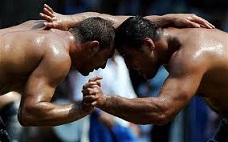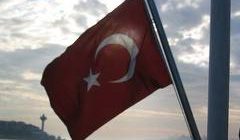Looking for Turkish wrestlers? Want to know about all the different characteristics of Turkish wrestlers? Read our guide for more information about Turkish wrestlers …
Turkish wrestlers take part in Turkish oil wrestling where the wrestlers are oiled from top to toe. They proceed to wrestle their opponent in what is termed as yagli gures is Turkish. It’s a form of Middle Eastern martial arts. It is played in the form of a sport and has its own set of wrestling regulations, rules, judges and penalties for breaching the rules.
Turkish wrestlers are known as pehlivan which is derived from the Persian word – pahlavan- which means champion or hero. During bouts, they wear hand stitched lederhosen called kisbet. This is a form fitting pants that starts from the hips and ends above the ankles. The kisbet is made from water buffalo hide or calf leather. The wrestlers will douse themselves in oil before commencing the wrestling bout.
Turkish wrestlers will win their match as long as they achieve a good hold of their opponent’s kisbet. One wrester will aim to overcome the other by grabbing and toppling the opponent. Then he puts his arm through his opponent’s kisbet. This winning move is termed paca kazik.
There are few holds that are forbidden in this special type of wrestling. Turkish wrestlers often include the grabbing of each other’s trunks as part of the repertoire of wrestling tactics. Matches display fierce aggressiveness among wrestlers and during a match, no quarter is sought nor given.
Modern Turkish Wrestling
The national championship of Turkish oil wrestling has been held since 1640 on an open grassy field near Edirne., the old capital of the Ottoman Empire. This tournament witnesses the gathering of more than 1000 Turkish wrestlers, both boys and men, in a championship called Kirkpinar.
This form of wrestling was introduced by the Janissaries, who were elite bodyguards of the Ottoman Sultans. Many Janissaries were of European descent. They were distinguished as a courageous and potent fighting regiment.
Traditionally, Turkish oil wrestling did not have a time limit and could drag on for more than a day until a wrestler emerged victorious. In 1975, the wrestling matches were timed and a limit was placed on the maximum time that a bout could progress without interruption. This time was capped at 30 minutes. This time is then extended for another 10 minutes if no there is no winner. Judges keep meticulous scores to determine the eventual winner.
Turkish wrestlers are far different from their Western counterparts with their well oiled bodies and tight fitting kisbet. The intimate holds that are allowed within Turkish wrestling would make Western wrestlers balk as the champion of a match is determined by the strong hold of an opponent’s kisbet.





